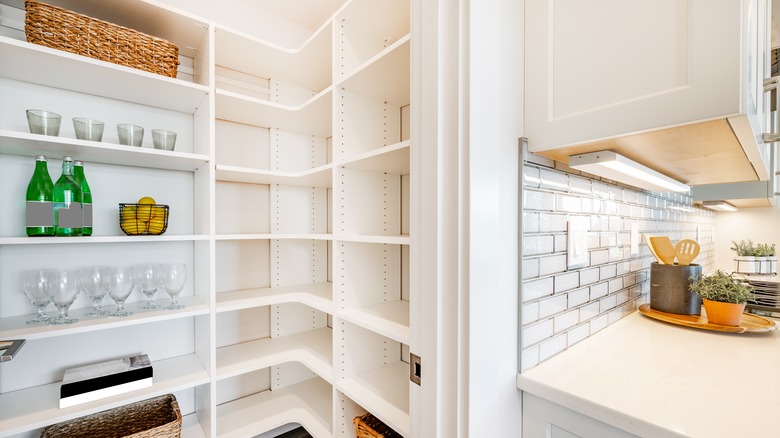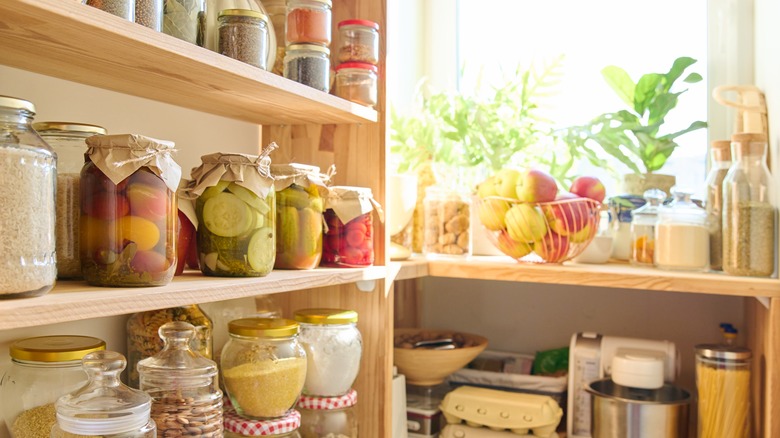DIY A Stunning Butler Pantry For Extra Kitchen Storage
Storage is essential for a functional kitchen, but it can sometimes be difficult to come by. In some kitchens, the standard cabinets don't always suffice. But adding a butler's pantry can add more storage to your kitchen. Luckily, TikTok user @down_mulberry_lane revealed how you can build a butler's pantry in your home with relative ease. They removed the existing floorboards before framing the space with wood boards. They wired the future room with electricity to add recessed lighting. Then, they put up the drywall, mudded, and primed the exterior for painting. Inside, they added cabinetry and countertops then installed two-by-one wood boards on the walls to have floating shelves. They finished off the room by adding two sliding barn doors.
The finished product provides storage for dry ingredients like flour, sugar, and rice, as well as what looks like cereals and snacks. Their DIY butler's pantry also has some storage for large appliances, like a rice dispenser and stand mixer, that will help free up some space on the kitchen counters and inside the cabinets. She further organizes the space by using jars and air-tight containers, which are transparent, so you can see what's inside. While the space is aesthetically pleasing, closing the sliding barn doors adds some separation and gives it the look of a traditional butler's pantry.
Cost of a DIY butler's pantry
Butler's pantries were popular in large, old homes as a place to store the silver, china sets, and serving platters. These rooms were a symbol of wealth and status, as not every home had these kinds of valuables or the staff to maintain them. Butler's pantries are no longer as common as they once were, and for homes that have them or add them, they're used to store different items.
The butler's pantry that @down_mulberry_lane DIY-ed was built by her husband, Mark — including the cabinets, wall shelving, electrical installation, and sliding door. However, to have a butler's pantry built by professional contractors can cost between $750 and $2,000, on average, for a small walk-in pantry about five-by-five feet. Bigger pantries that are 100 square feet (or larger) can cost between $2,000 and $3,500 to build and outfit with shelves, cabinets, and countertops.
However, when DIY-ing a pantry, you won't have to pay those labor costs, and you'll only have to pay the cost of materials. Because they framed in a new room, this particular DIY pantry would be on the less expensive side. Lumber for framing costs about $1 to $5 per square foot, stock cabinets can cost $220 to $500 per unit, and two-by-one wood boards are $1.27 each. Sliding doors can vary between about $200 and $600. The cost of materials may be a couple hundred to a couple thousand.
Building and organizing a butler's pantry
Framing in a new room is relatively easy to do if you have some carpentry experience. To start, you'll need a circular saw, framing hammer, framing nails, tape measure, stud finder, shims, carpenter square, plumb bob, chalk line, and lumber boards. Start by measuring the space on the walls and ceiling and using the chalk line to mark them. Hang the plumb bob from the ceiling to mark the line on the floor so the walls line up. Cut the studs for the new wall and assemble them into a frame. Once the frame is complete, you can lift the wall into place and secure it using a framing hammer and nails into the floor frame, the ceiling, and any existing walls. You may want to have a professional install the electric system, and after that, you can install drywall, prime, and paint the room.
Now comes the time to outfit it. TikTok user @down_mulberry_lane used her butler's pantry for storing dry ingredients and some larger appliances. This space is ideal for storing kitchen tools you may not use daily, such as a slow cooker, blender, or mixer, in order to keep the counters in the main kitchen clear. Similarly, you can store plates or serving ware you use when you have company, similar to the original use. The goal of a butler's pantry is to provide storage for larger or rarely used items to keep your kitchen more functional.

